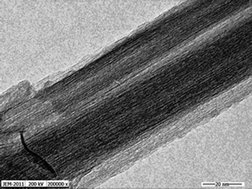Determination of paraquat and diquat preconcentrated with N doped TiO2nanotubessolid phase extraction cartridge prior to capillary electrophoresis
Abstract
This paper describes a new method for rapid and sensitive determination of

* Corresponding authors
a
State Laboratory of Petroeum Resource and Prospecting, College of Geosciences, China University of Petroleum, Beijing Capmus(CUP), Beijing, China
E-mail:
zhouqx@cup.edu.cn
Fax: +86-10-89733422
Tel: +86-10-89733422
b School of Chemistry and Environmental Sciences, Henan Normal University, Key Laboratory for Yellow River and Huaihe River Water Environment and Pollution Control, Ministry of Education, Henan Key Laboratory for Environmental Pollution Control, Xinxiang, PR China
c Department of Chemistry, University of Science and Technology Beijing, Beijing, PR China
d College of Resources and Environment, Henan Institute of Science and Technology, Xinxiang, China
This paper describes a new method for rapid and sensitive determination of

 Please wait while we load your content...
Something went wrong. Try again?
Please wait while we load your content...
Something went wrong. Try again?
Q. Zhou, J. Mao, J. Xiao and G. Xie, Anal. Methods, 2010, 2, 1063 DOI: 10.1039/C0AY00250J
To request permission to reproduce material from this article, please go to the Copyright Clearance Center request page.
If you are an author contributing to an RSC publication, you do not need to request permission provided correct acknowledgement is given.
If you are the author of this article, you do not need to request permission to reproduce figures and diagrams provided correct acknowledgement is given. If you want to reproduce the whole article in a third-party publication (excluding your thesis/dissertation for which permission is not required) please go to the Copyright Clearance Center request page.
Read more about how to correctly acknowledge RSC content.
 Fetching data from CrossRef.
Fetching data from CrossRef.
This may take some time to load.
Loading related content
